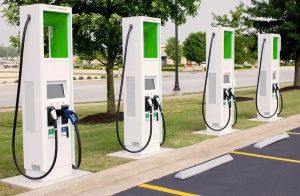


Is DC Fast Charging Bad for EV Battery?What Is Fast Charging?
Is DC Fast Charging Bad for Your EV Battery?
Introduction
As a professional EV charger manufacturer in China, Topper Company delivers dependable electric vehicle charging station equipment and comprehensive charging solutions.
Electric vehicles (EVs) have transformed the auto industry, providing a cleaner alternative to gasoline-powered cars. As EV adoption rises, fast and efficient charging becomes crucial. DC fast charging promises quick refueling, but concerns exist about its effect on battery health. Let’s explore how DC fast charging works, how it compares with other methods, and whether it harms your EV battery over time.
What Is Fast Charging?
Fast charging refers to rapidly replenishing an EV’s battery in a short time, often under an hour. Unlike Level 1 (120V) and Level 2 (240V) charging, which use alternating current (AC) and can take several hours, DC fast charging delivers high-voltage direct current (DC) directly to the battery. This bypasses the vehicle’s onboard AC-to-DC converter, allowing much faster energy transfer.
Levels of EV Charging
Level 1: Standard 120V outlet, adds 2–5 miles of range per hour—suitable for overnight home charging.
Level 2: Uses 240V (like a dryer), adds 10–30 miles per hour—common in homes and public stations.
Level 3 / DC Fast Charging: Supplies DC directly, can charge up to 80% in 20–30 minutes—ideal for road trips or quick top-ups.
How DC Fast Charging Works
AC charging requires your EV’s onboard system to convert power to DC before storing it. DC fast chargers do the conversion before the power reaches the car, enabling faster, more efficient charging. However, this high power output also increases stress on the battery.
What Affects Fast Charging Speed?
Battery Temperature: Extreme cold or heat can slow charging or trigger protective limits.
Charger Power: Ranges from 50 kW to 350 kW—higher power equals faster charging.
Battery State of Charge (SoC): Charging is fastest from low SoC; it slows as the battery nears full.
Station Load: If multiple cars are charging, power may be split, reducing speed.
Battery Health Concerns
Heat Generation: High-speed charging increases internal battery temperature, which can degrade chemical components over time.
Battery Stress: Rapid energy intake causes more wear than slower charging, especially if done frequently.
Decreased Efficiency: Repeated fast charging may accelerate loss of capacity, reducing range and overall performance.
When to Use DC Fast Charging
DC fast charging is safe and useful when:
Traveling long distances
Lacking access to Level 2 charging
Facing time constraints
But for daily use, Level 2 charging is better for battery longevity.
Modern Battery Protections
Most EVs come with Battery Management Systems (BMS) that monitor temperature, SoC, and charge rate to protect against damage. While helpful, they don’t eliminate long-term wear from frequent fast charging.
Conclusion
DC fast charging is a powerful tool for EV drivers, offering speed and convenience. However, using it too often can accelerate battery wear due to increased heat and stress. Reserve DC fast charging for urgent needs or travel, and rely on Level 2 charging for regular use. Balancing both approaches ensures better long-term battery health and performance.Know more about Google SEO Directory
